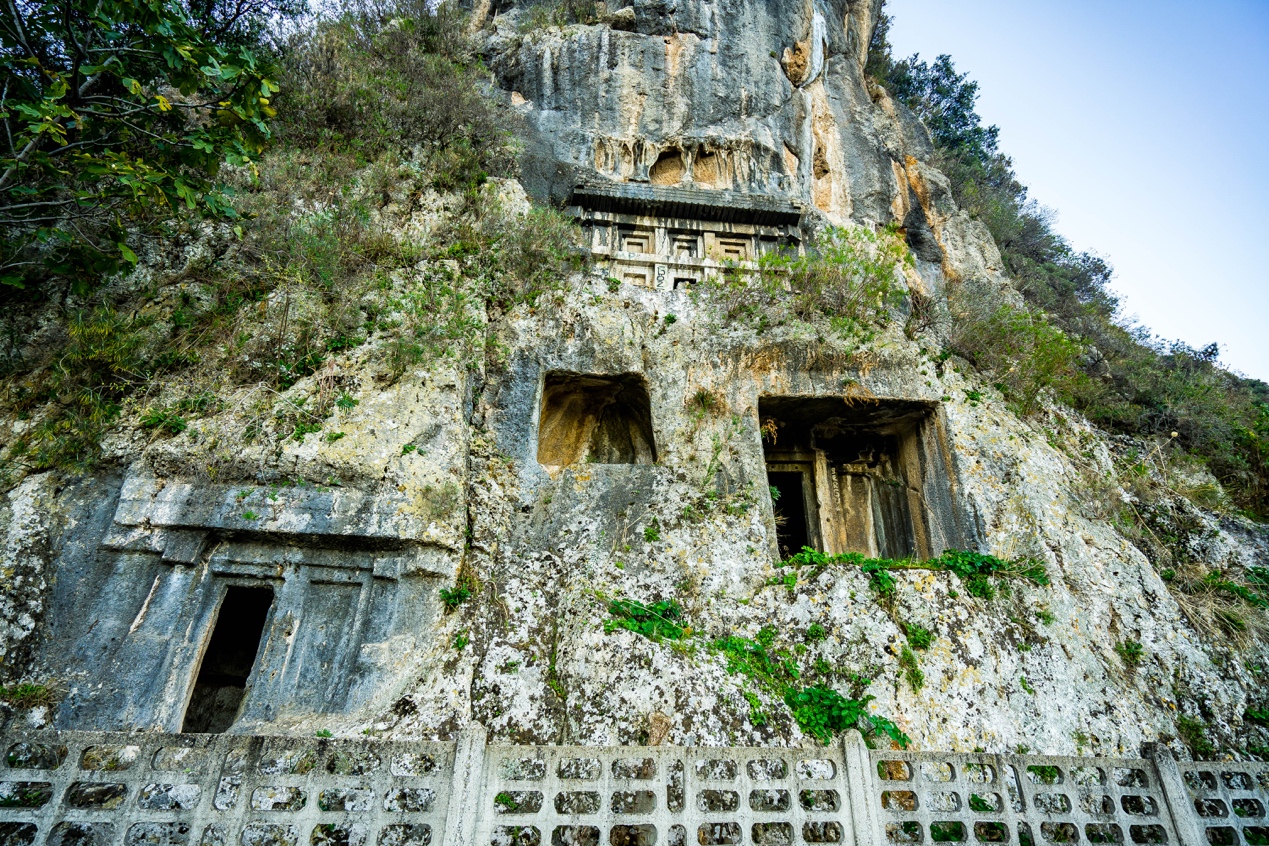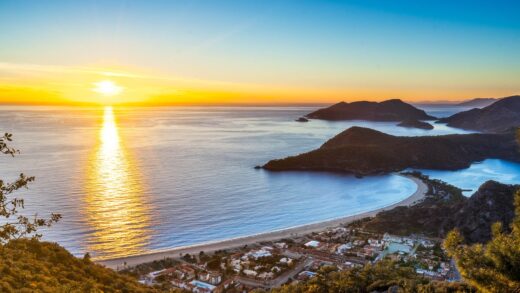The story (in Chinese) was first published in Issue 10/2021 of Lonely Planet China magazine.
This English version was translated from the Chinese original with DeepL, with the manual correction of some obvious mistranslations.. I apologize for any mistakes made by this AI translation tool.

Few long-distance hiking trails around the world combine spectacular natural beauty and rich history as beautifully as the Lycian Way. From Fethiye to Antalya, Turkey’s Tekke peninsula juts out into the Mediterranean in a near-perfect semicircle. The arc that winds along the coast is where the more than 500-kilometre-long Lycian Way is located.
The plane streaked across the autumn sky and landed steadily at Dalaman airport, 45 km from Fethiye. It was the first time I had seen the Mediterranean Sea with my own eyes, and the blue sea that swept low on the approach to landing immediately made me look forward to this trip along the coast.

To most Chinese tourists, Fethiye, a small city at the western end of the Lycia Road, is just one of the thousands of destinations in Turkey. But as soon as you get off the plane, a more international feel than Istanbul comes over you. For example, you can take the local bus directly with your international credit card. And on the way into town, I saw restaurants from every country – British fish and chips, German beer and sausages, even Indian curries and Chinese stir-fries. It’s a sight you don’t see in small towns in Turkey.
The owner of the B&B was a kindly aunt, and after listening to her detailed description of the food and drink in the neighbourhood, I took the opportunity to express my feelings about the “cosmopolitan” nature of Fethiye.
“What, that you don’t know that Fethiye is what it is today entirely because of foreigners! They came mainly to settle, but there were quite a few tourists too. Well, most of them are British.” She casually handed over the menu for the B&B. Sure enough, “fish and chips” was listed alongside “sandwiches” and “pasta” on the humble white sheet that offered only a few choices. I laughed in disbelief.
In her account, Fethiye was a small fishing village 20 years ago (“When we built this house, my husband had to drive to another city to buy a nail, can you believe it?”) But it was the influx of foreign tourists and settlers, seemingly overnight, that turned it into the bustling metropolis it is today, with all the traffic and restaurants from all over the world.
Today more than 5% of Fethiye’s population of 150,000 are foreign settlers (over 80% of whom are British). This means that a casual glance around Fethiye’s busy neighbourhoods will almost certainly include more than one Englishman as far as the eye can see.
John was one of them. I saw him in the middle of a marina full of various yachts on the beach. Seeing me taking pictures, he warmly greeted me with a cup of tea on his sailboat. That was how I easily met my first Englishman in Fethiye. Technically, John was born in Ireland, but with over 30 years of experience in finance in London, he was no different from a native Londoner in everything from his temperament to his accent.

“I’m a crazy sailing enthusiast. I used to sail my boat all over Europe every year on vacation. Now I’m old and finally retired. Maybe it’s time to buy a house in Fethiye and live out my days in peace. When my wife retires next year too, we’ll move over and live here.”
I took the opportunity to ask the question that had been puzzling me, “Why Fethiye?”
“Sunshine, beaches, always warm weather, too much …… Sadly, we don’t have any of that in England, and neither does Ireland. Oh, thank God, Fethiye has it all.” He paused for a moment, as if thinking of a more convincing argument, “And for me, there’s a whole bunch of English friends and fish and chips. By the way, did you know that the Turks call this place ‘Little England’?”
This last joke amused us both. Because of British immigrants, this Turkish city, which has a very different atmosphere and climate from England, has become what Turks call “Little England”.
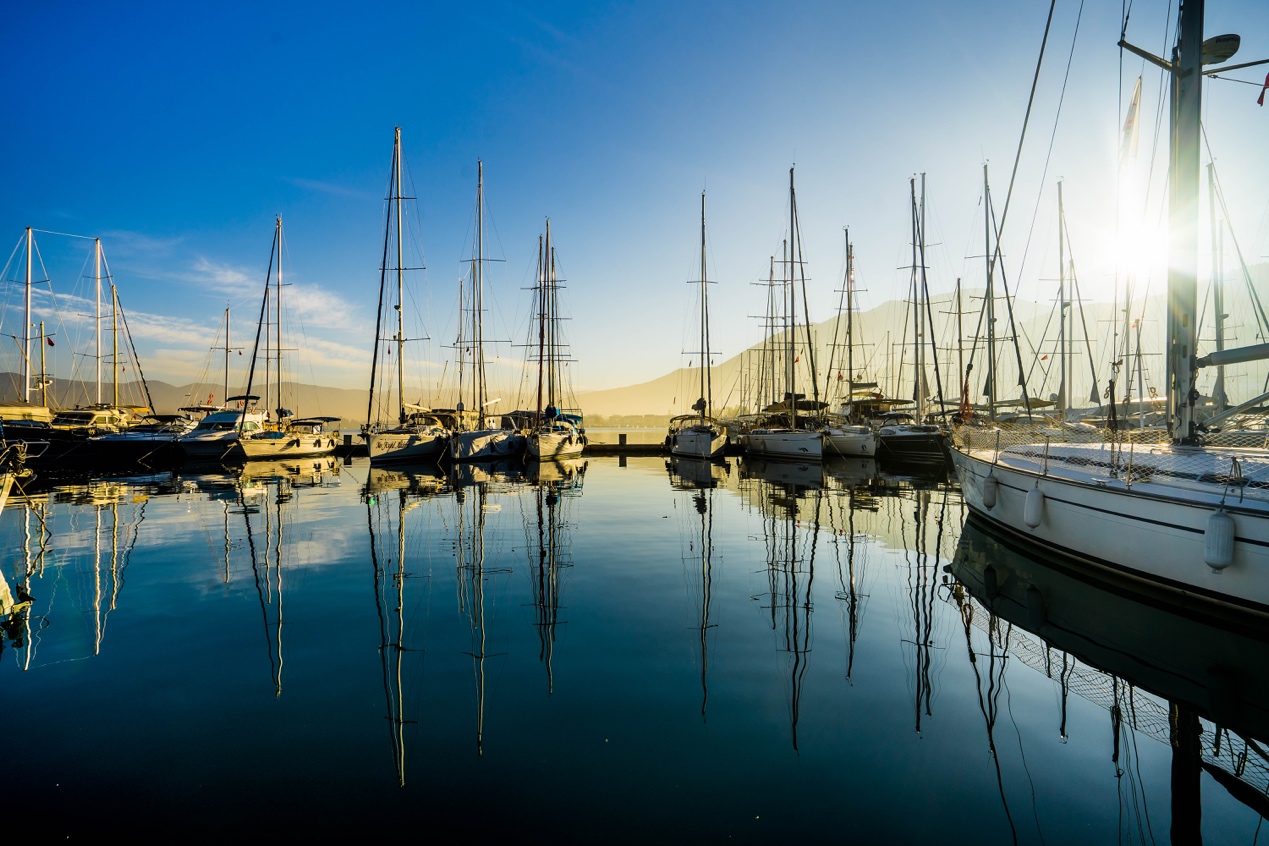
“So, how much is it about to buy a house here?” I asked casually. Thinking, since the British tend to go for it, it shouldn’t be too cheap.
John pulled out his fancy glasses, opened his phone and flipped out the photos he’d taken during the viewing to show me, “This is the one I’m looking at, it’s about £200,000.” “Two hundred thousand?” I repeated the figure in surprise to make sure I had heard it right. This two-storey villa on the outskirts of Fethiye, with panoramic views of the coast and equipped with a private garden and swimming pool, was only about 1.8 million RMB.
“Well, now you know the ‘real’ reason I chose Fethiye.” He laughed out loud, “Anyway, the Americans own Florida, but we can own Fethiye.”
“And you, what do you plan to do in Fethiye?”
“I plan to follow the Lycian Way and seek out the monuments here one by one. Their mysterious history is just too fascinating to me.” This is indeed the real reason why I came to Fethiye. The rolling wheels of history will always be more exciting to me than a thousand suns and beaches.
The name “Lycia” comes from the Lycian civilization that stretched over 2,000 years in this region. The ancient Greek scholar Herodotus, in his famous book “History”, recorded that the ancestors of the Lycians were the sons of the mythical Phoenician princess Europa, Sarpedon, who fled from Crete across the sea to settle here after a failed political dispute with his brother. The reality, however, does not seem to be so bleak: much evidence suggests that the Lycian origins have little to do with the ancient Greeks. Although the Lycian script borrows from the Greek alphabet, the mysterious language behind the writing has not yet been fully deciphered.
The location of Fethiye is right at the western end of the Lycia civilization. Because of the recent spontaneous expansion of the city’s present-day layout, the modern city of Fethiye overlaps almost exactly with the ancient Lycian city of Telemessos. Next to the upscale residential area facing the sea is the amphitheatre, which is over 2,000 years old, and more easily seen are the hanging coffins of the Lycians, which are scattered almost “randomly” everywhere: on the side of the road, next to buildings, and even at the roundabout in the centre of the junction.
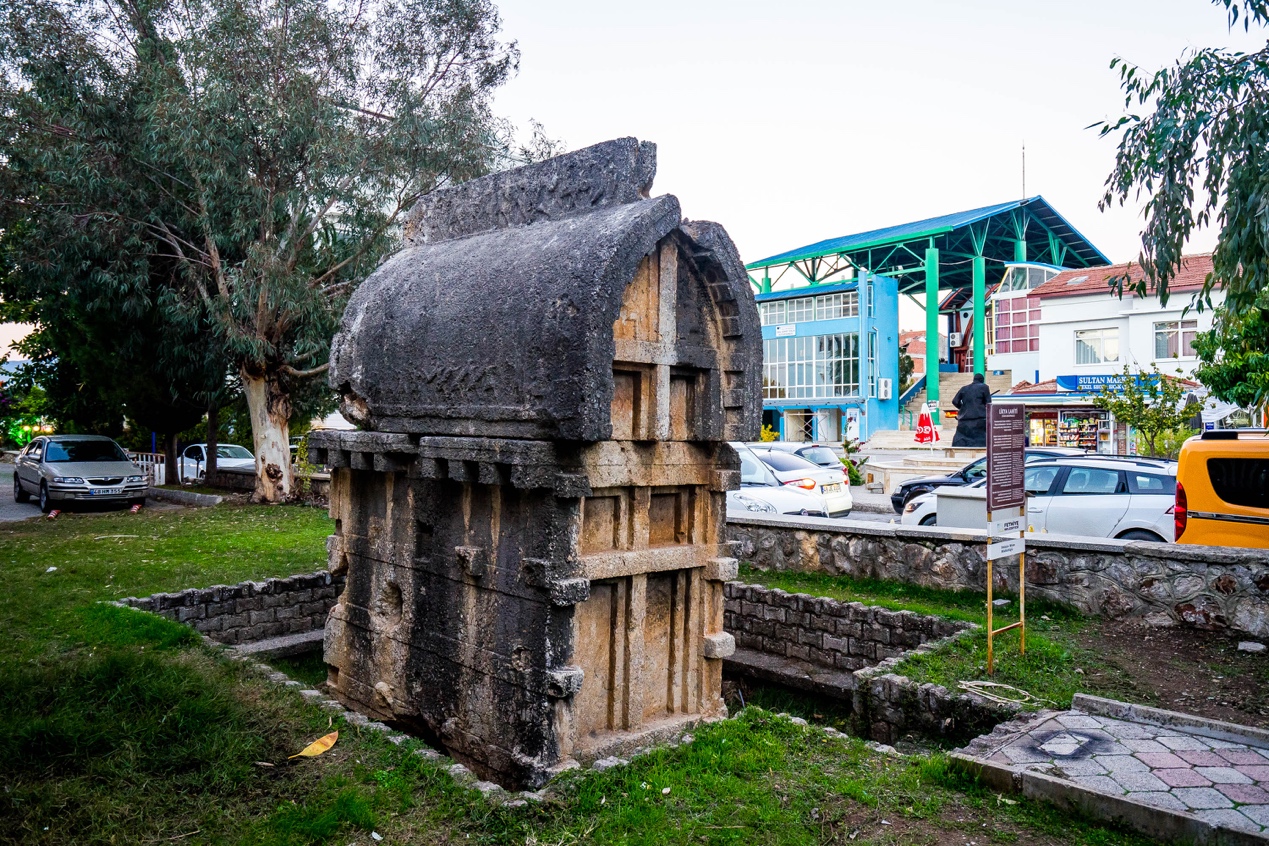
The burial of the dead in hanging coffins is the most famous Lycia custom. It is assumed that the Lycans believed that after death the soul would ascend to heaven, and therefore spared no expense to build their tombs “closer to heaven” on high ground. One of the more “commonplace” burials was a sarcophagus placed on a pedestal above the ground, which can be seen throughout the Teche Peninsula. Those in high and powerful positions in Lycia chose to spend large sums of money to have their suspended coffins cut into the rocky cliffs, not unlike the practice of the Ba people of the Three Gorges in China.
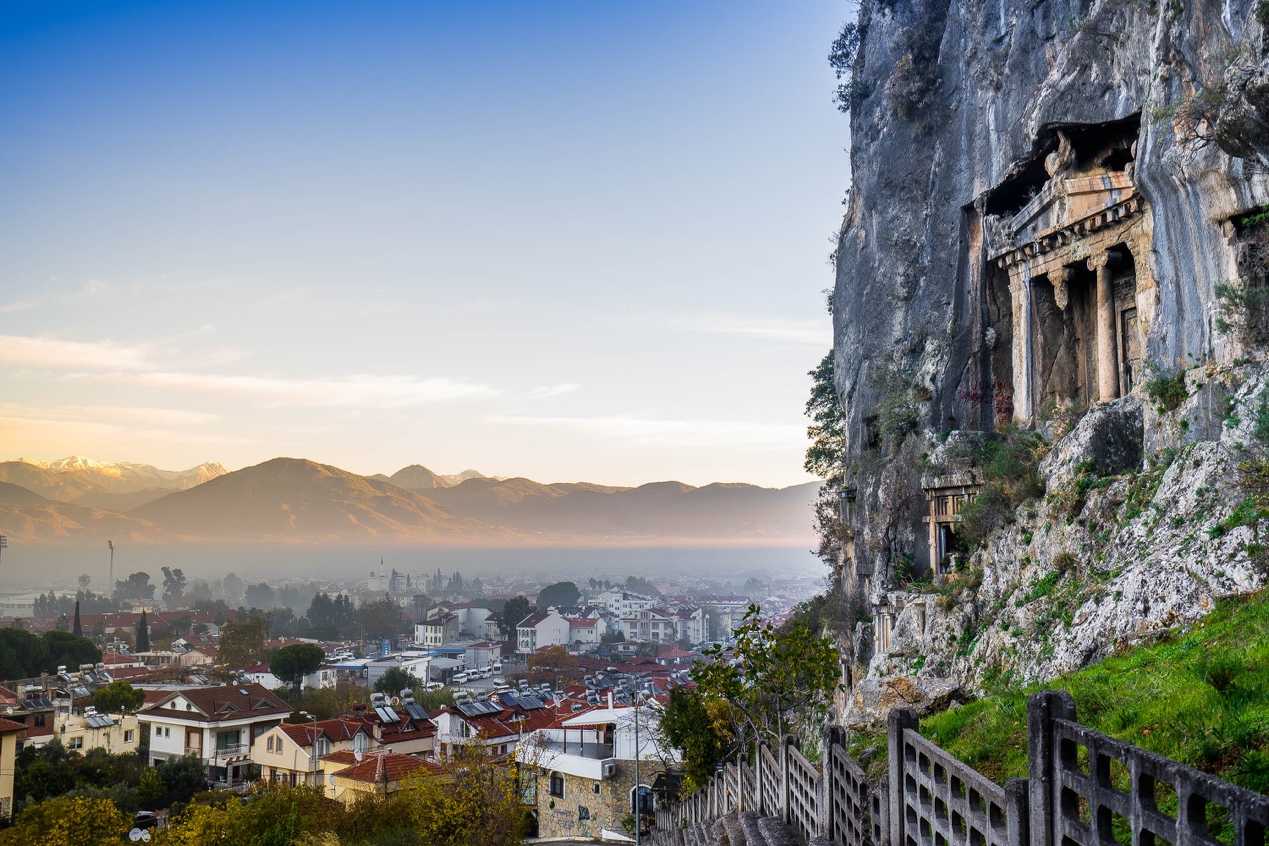
Early the next morning, while the morning sun was dawning and both the blazing sun and the sightseers were still awake, I climbed alone up a small hill outside the city where some of the most famous hanging coffins in the neighbourhood were situated. The tombs undoubtedly belong to the Lycians, and yet the style of the buildings clearly shows a strong influence from Greek and Persian architecture. The most famous of these, according to its inscription, was built in 350 B.C. and was owned by “Amintas, son of Hermanus”. The identity of many of the other tombs is still unknown, and only the lofty Greek triangular friezes and elaborate columns on the cliffs remain to show off their owners’ former glory.
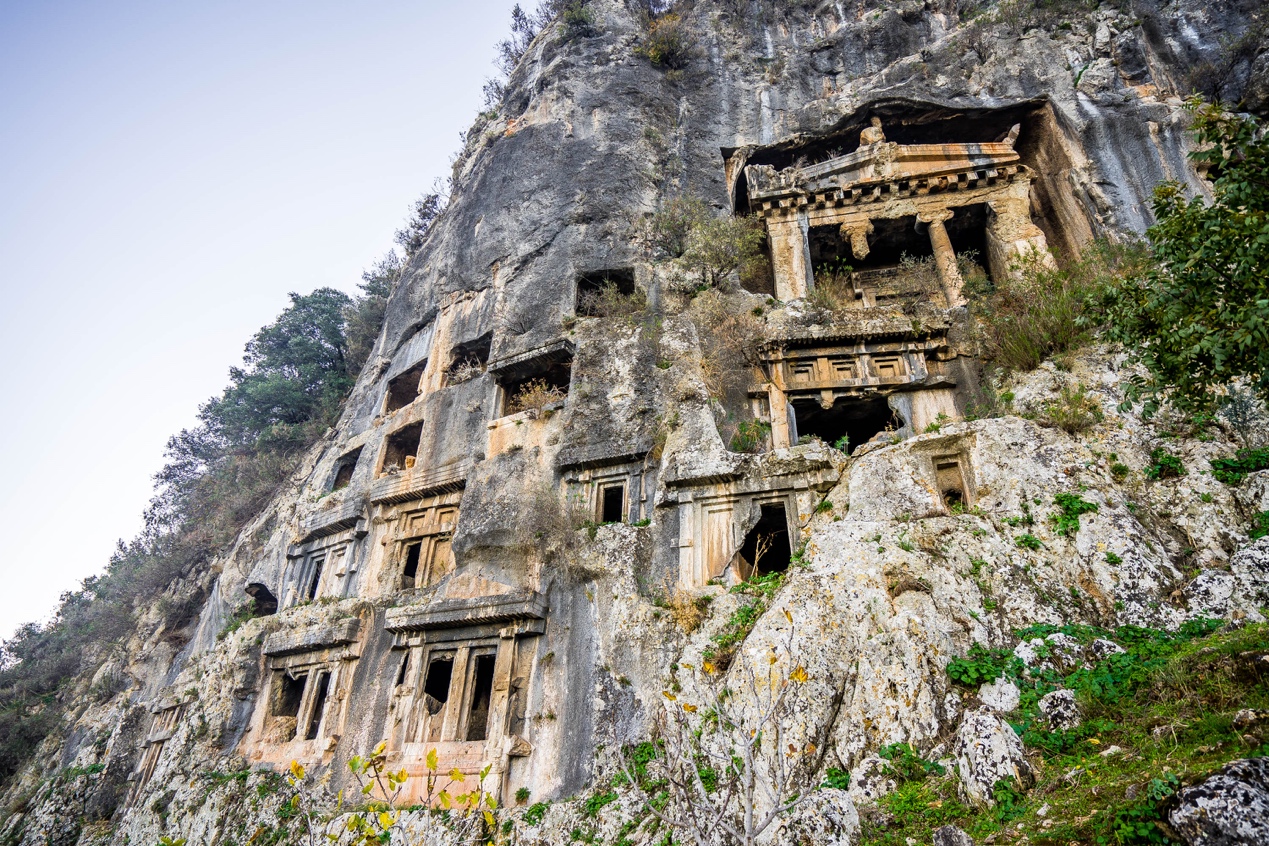
It’s a pity that the sarcophagus and the burial goods in the tomb must have been lost long ago, and the few remaining statues are mostly damaged due to water seepage over the years, which is probably the biggest problem of building the tomb under broad daylight. I can only silently pray that the souls of the tomb owners have already ascended to their heaven before this.
